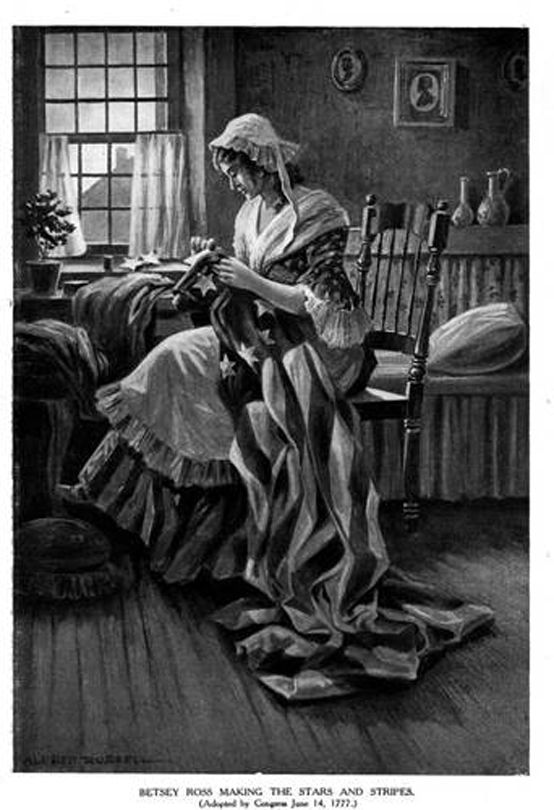Many heroes and heroines grace the pages of colonial American history. The legend of one such heroine is Betsy Ross, credited with making the first American flag. Her legacy embraces our national freedom: the blue field, which represents our national character, the red and white stripes to symbolize the thirteen original colonies, and fifty white stars to number the current states in the Union.
Betsy Ross lived the Revolution that brought our country into being. She was
born in Philadelphia January 1, 1752, the sixth of eighteen children, although
several of her sisters and three of her four brothers died in infancy. The day
of her birth the colonial world abandoned the Julian calendar, which began in
March, and embraced the Julian calendar, beginning January first. Her posterity
thereafter declared that Betsy was born on the first day, month, and year of a
new era.
Betsy embraced the artisan world of
fabrics--bed accessories, hand made mattresses, upholstery, window coverings,
and flags. Her life was set among the swelling cries for independence in the
colonies as they struggled against self-serving British rule. She met her first
husband, John Ross, as they worked together, and as a married couple they ran
their own small upholstery shop. Their families stood on opposing sides of the freedom
divide—John’s declaring for freedom, Betsy’s Quaker family rebuffing the war to
match their religious beliefs.
John’s death 26 months after their
marriage left Betsy alone, childless, and self-supporting. Her second marriage,
of five years duration, was to mariner Joseph Ashburn. He spent much of their
marriage at sea and the last 6 months of his life confined in an English prison
after being captured as sea. Betsy’s third husband, John Claypoole, was also a
prisoner in England’s Old Mill prison and attended Joseph Ashburn as he died.
Comforting Betsy in her loss, the two fell in love and married, raising her two
daughters by Ashburn and their five daughters together.
The
legend of Betsy Ross and the first American flag began in 1870, 34 years after
her death. William Canby, her only living grandson, related the following oral
tradition told around the family fire to the Historical Society of
Pennsylvania.
Colonel
George Washington and George Ross, uncle of her first husband, came to Betsy’s
shop sometime in the year 1775 to announce that they were appointed to prepare
a national flag and wished her to make it. They produced a rough drawing and
enlisted Betsy’s help to create the flag, which she consented to do. However,
her practiced eye recognized a defect in the plan: the proposed stars were
six-pointed, rather than the simpler star with five points. Taking paper in
hand she deftly folded, then snipped, a five star design, which the pleased gentlemen
gladly accepted for the final product. Upon completion, a delighted Washington flew Betsy’s flag from a ship
lying at the wharf, where it received the unanimous approval of the committee,
bystanders looking on, and ultimately Congress. Col. Ross later gave Betsy an
unlimited order for as many flags as she could make.
While
the story is heartwarming and generally applauded, it is not accurate. Our
national flag was an evolving product, with Betsy Ross contributing her
share---the five pointed star and possibly other ideas—to its design.
While stars of many points continued to grace flags of the period, the five
pointed design eventually prevailed. Many prototypes existed and many minds
generated ideas to ultimately create our national standard. The design was formalized in 1777, but
variants continued to appear for many years afterward.
Betsy Ross continued
to make flags, along with upholstery products, for most of her remaining years,
until her death at age 84. Many others also
paralleled her craft, lending their efforts to create the national standard
of freedom that stirs our hearts today as it floats from flagpoles across the
nation.
- Pam

No comments:
Post a Comment